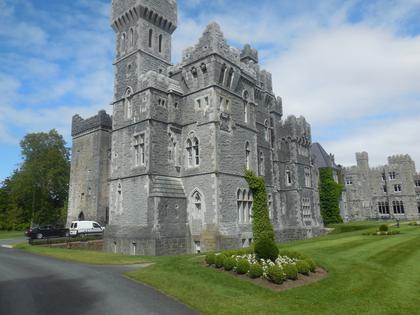Taking the Kids: Visiting an Irish castle
It was all in the wrist. And I learned this the hard way at Ireland’s School of Falconry. The school is the oldest in the country — at Ashford Castle in western Ireland. The castle dates back to 1228 on the shores of Lough Corrib, the largest lake in Ireland, and the River Cong, which is reputed to have the best salmon and trout fishing in Europe. Ashford Castle has long been popular with American families. One tween I met from Michigan decided he wanted to move here; his younger brother was enthralled that a falcon landed on his arm.
We visited nearly a decade ago, but the experiences still are the same. Miles of bike, hiking and jogging trails — the 350-acre estate has 26 miles itself, but it connects with 5,000 acres. Just the chance to look around the historic castle is an adventure in itself — the chance to take a selfie next to a suit of armor, a layered 3-foot-tall tiered tray – as tall as a kid – filled with dainty sandwiches (no crusts), pastries, and hot scones with lemon curd and clotted cream for tea. You can go on a picnic or learn to fish as well.
Ashford in County Mayo in the West of Ireland is the oldest castle hotel in Ireland. A hotel since 1938, it has undergone a complete renovation since being acquired by Red Carnation Hotels. In addition to the 82-room castle, there is a more casual (and less expensive) 50-room lodge on the castle grounds that I think is ideal for families with its two-story units. But despite the hefty rates, many guests are families, particularly multi-generational groups.
“’Very expensive but definitely worth it,” one grandmother told me.
Happy St. Patrick’s Day! St. Patrick's Day observes the death of St. Patrick, the patron saint of Ireland. The holiday has evolved into a celebration of Irish culture with parades, special foods (corn beef and cabbage, perhaps?), music, dancing, drinking and a whole lot of green, especially shamrocks — in the U.S., as well as in Ireland.
By the 17th century, the shamrock had become a symbol of emerging Irish nationalism. As the English began to seize Irish land and make laws against the use of the Irish language and the practice of Catholicism, many Irish began to wear the shamrock as a symbol of their pride in their heritage and their displeasure with English rule.
Perhaps there is no better time to visit Ireland – and an Irish castle, or two, perhaps even staying in one. There are thousands of castles and ruins left in Ireland today, most dating from the 12th to 16th centuries. Many were built as fortresses; others were homes for royalty, religious centers and even prisons. (In case you are wondering, Germany has even more, and Wales has the most castles per square mile.)
Some are ruins like Dunluce Castle — all that’s left of a medieval fortress said to have inspired CS Lewis to create Cair Paravel, the capital of Narnia. Banshees (fairy ghosts) are said to haunt the place.
During the Irish revolutionary period (1919 to 1923) nearly 300 big country houses were burned or blown up by the Irish Republican Army because their owners showed sympathy to England or were English aristocracy.
Many of those grand country houses only dated from the early 18 th century — centuries younger than the castles Ireland is famous for, today including more than 20 castle hotels, according to CelticCastles.com. You can stay in one where you are treated like a queen or king; or even a self-catering castle like Ballyportry that only sleeps six in a Gaelic tower house that’s 90 feet high ($3,230 for three nights) or Belle Isle Castle that sleeps 31 (a little less than$4,000 a night)
...continued
(c) 2024 DISTRIBUTED BY TRIBUNE MEDIA SERVICES, INC.










